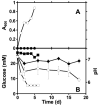Electrochemical Detection of Carbon Steel Corrosion Induced by Fermentative Bacteria From Natural Gas Transmission Lines
- PMID: 39657260
- PMCID: PMC11630862
- DOI: 10.1111/1758-2229.70058
Electrochemical Detection of Carbon Steel Corrosion Induced by Fermentative Bacteria From Natural Gas Transmission Lines
Abstract
The metabolic potential and corrosive activities of a fermentative bacterial enrichment culture from a natural gas transmission line were characterised. Three metagenome-assembled genomes (MAGs) attributable to Cytobacillus, Lacrimispora and Staphylococcus spp. were obtained. These MAGs hosted genes involved in the fermentation of carbohydrates to organic acids, which was reflected in the acidification of the growth medium by the culture. To evaluate the corrosive activities of the culture, it was incubated in a split chamber-zero resistance ammetry (SC-ZRA) format. This involved deploying carbon steel coupons immersed in liquid medium in opposing chambers of an electrochemical cell. Measurement of current between the coupons indicated the extent and mechanism of corrosion. When the enrichment culture was added to one side of an SC-ZRA incubation with bicarbonate-buffered medium, pH change and corrosion were minimal. In bicarbonate-free medium, the culture acidified the medium, induced electron transfer from the uninoculated chamber to the inoculated chamber, and caused mass loss. These results indicate that fermenter-induced microbially influenced corrosion (MIC) is due to localised fluid acidification, inducing anodic reactions on the metal surface exposed to the microorganisms and mass loss of the non-exposed metal.
Keywords: acid production; fermenter; microbially influenced corrosion; natural gas.
© 2024 The Author(s). Environmental Microbiology Reports published by John Wiley & Sons Ltd.
Conflict of interest statement
The authors declare no conflicts of interest.
Figures


Similar articles
-
Use of an Electrochemical Split Cell Technique to Evaluate the Influence of Shewanella oneidensis Activities on Corrosion of Carbon Steel.PLoS One. 2016 Jan 29;11(1):e0147899. doi: 10.1371/journal.pone.0147899. eCollection 2016. PLoS One. 2016. PMID: 26824529 Free PMC article.
-
Uniform and Pitting Corrosion of Carbon Steel by Shewanella oneidensis MR-1 under Nitrate-Reducing Conditions.Appl Environ Microbiol. 2018 May 31;84(12):e00790-18. doi: 10.1128/AEM.00790-18. Print 2018 Jun 15. Appl Environ Microbiol. 2018. PMID: 29654179 Free PMC article.
-
Isolation of a sulfide-producing bacterial consortium from cooling-tower water: Evaluation of corrosive effects on galvanized steel.Anaerobe. 2017 Feb;43:27-34. doi: 10.1016/j.anaerobe.2016.11.005. Epub 2016 Nov 18. Anaerobe. 2017. PMID: 27871998
-
The dual role of microbes in corrosion.ISME J. 2015 Mar;9(3):542-51. doi: 10.1038/ismej.2014.169. Epub 2014 Sep 26. ISME J. 2015. PMID: 25259571 Free PMC article. Review.
-
Damage to offshore production facilities by corrosive microbial biofilms.Appl Microbiol Biotechnol. 2018 Mar;102(6):2525-2533. doi: 10.1007/s00253-018-8808-9. Epub 2018 Feb 8. Appl Microbiol Biotechnol. 2018. PMID: 29423635 Review.
References
-
- Annuk, H. , and Moran A. P.. 2010. “Microbial Biofilm‐Related Polysaccharides in Biofouling and Corrosion.” In Microbial Glycobiology: Structures, Relevance and Applications, edited by Holst O., Brennan P. J., and von Itzstein M., 781–801. Burlington, MA: Academic Press.
-
- ASTM International . 2011. Standard Practice for Preparing, Cleaning, and Evaluating Corrosion Test Specimens. ASTM G1‐03. West Conshohocken, PA: ASTM International.
MeSH terms
Substances
Grants and funding
LinkOut - more resources
Full Text Sources
Miscellaneous

